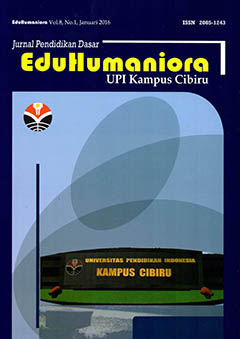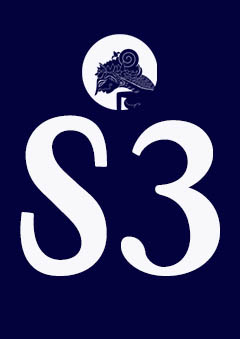Pengembangan Model Penyusunan Kurikulum Tingkat Satuan Pendidikan (KTSP) yang Mengacu pada Standar Nasional Pendidikan
Abstract
This research is performed due to the presence of gap between the policy in the improvement of curriculum and the existing field‐condition in elementary school. On one side School‐Based Curriculum (KTSP) is expected to be applied in schools autonomously, on the other hand, neither the principals nor the teachers, especially of elementary schools, have had comprehensive understanding on the concept of School‐Based Curriculum, its construction process, as well as the implementation. The problem of this research, therefore, is ”How is a model for the construction of School‐Based Curriculum that refers to National Education Standard developed to result in School‐Based Curriculum (KTSP) document”?
With reference to the above mentioned background, this research is purposed to offer facilities to schools, especially elementary schools, in the process of constructing School‐Based Curriculum that refers to the guideline of KTSP construction by Badan Standar Nasional Pendidikan (National Standard Agency for Education), so that they can have KTSP document. In other words, this research will result in a product of the process of School‐Based Curriculum (KTSP) model development for KTSP document.
In order to achieve the objectives, this research is conducted using Research and Development approach. In the implementation, this research and development forms a cycle, which begins with a preliminary study to find an early product required. This early product is then developed in a certain condition, with a test, the result of which is revised and retested until the final product, which is considered satisfactory, is obtained. The validity of this final product is then examined. This research is conducted in elementary schools in Cileunyi District of Bandung Regency, of which the principal and the teachers become the subject of this research.
Referring to the Research and Development measures, as mentioned above, the process of constructing School‐Based Curriculum (KTSP) contains two stages. The first stage is the work discussion of the team that consists of Headmaster as the chairman, teachers, and school committee, and involves related parties from the Subdistrict Office of National Education Department and experts (in this case: the research team), which produces book 1 containing general guideline of School‐Based Curriculum (KTSP) development. The second stage is the work discussion of the research team, Headmaster, and teachers, which produces book 2 consisting of six copies of books for each grade, from the first to the sixth. Suggestions put forward in this research is that the socialization of School‐Based Curriculum (KTSP) should be carried out in whole and applicable so as to give clear description of the process and product of School‐Based Curriculum (KTSP) construction to those school, since they –elementary schools in particular‐ have not been able to create School‐Based Curriculum (KTSP) autonomously.
Full Text:
PDF (Bahasa Indonesia)References
Badan Standar Nasional Pendidikan (2006). Panduan Penyusunan KurikulumTingkat Satuan Pendidikan
Jenjang pendidikan Dasar dan Menengah. Jakarta. Depdiknas.
Hasan, S. Hamid. (1988). Evaluasi Kurikulum. Jakarta: Depdikbud.
Hanafie Imam. (2007). Plus Minus Kurikulum Tingkat Satuan Pendidikan. [Online). Tersedia: http//www.
mahanive@yahoo.com
Ibrahim dan Karyadi, Beny. (1990). Materi Pokok: Pengembangan Inovasi dan Kurikulum. Jakarta:
Depdikbud.
Jalal, Fasli & Supriadi, Dedi. (2001). Reformasi Pendidikan dalam Konteks Otonomi Daerah.
Yogyakarta: Depdiknas‐Bappenas‐Adicita Karya Nusa.
Longstreet, Wilma S & Shane, Harold G. (1993). Curriculum for a New Millennium. Boston: Allyn
and Bacon.
Mulyasa, E. (2003). Kurikulum Berbasis Kompetensi: Konsep, Karakterstik, dan Implementasi.
Bandung: Remaja Rosdakarya.
Mulyasa, E. (2006) Kurikulum yang Disempurnakan: Pengembangan Standar Kompetensi dan
Kompetensi Dasar. Bandung: Remaja Rosdakarya.
Nasution, S. (1991). Pengembangan Kurikulum. Bandung: Citra Aditya Bakti.
Oliva, Peter F. (1992). Developing the Curriculum. United States of America:
HarperCollinsPublishers.
Peraturan Menteri Pendidikan Nasional Nomor. 22 Tahun 2006 tentang Standar Isi Untuk Satuan
Pendidikan Dasar dan Menengah.
Peraturan Menteri Pendidikan Nasional Nomor 23 Tahun 2006 tentang Standar Kompetensi
Lulusan untuk Satuan Pendidikan Dasar dan Menengah.
Pusat Kurikulum (2007). Model Penilaian Kelas Kuriikulum Berbasis Kompetensi. [Online).
Tersedia:http://www.Puskur. Net.
Sanjaya, Wina. (2005). Pembelajaran dalam Implementasi Kurikulum Berbasis Kompetensi. Jakarta:
Prenada Media.
Sinclair, Robert L.(2003). Menggagas Kurikulum: Mencari Pijakan. Yogyakarta: UNY.
Soehendro, Bambang. (2006). Kurikulum KTSP. [Online). Tersedia: http://ktsp.jardiknas.org/
Sukmadinata, Nana Syaodih. (1997). Pengembangan Kurikulum: Teori dan Praktek. Bandung PT Remaja
Rosdakarya.
Sumantri, Mulyani. (1988). Kurikulum dan Pengajaran. Jakarta: Depdikbud.
Tim Broad Based Education & Depdiknas (2002). Pendidikan Berorientasi Kecakapan Hidup (Life
Skill) Melalui Pendekatan Pendidikan Berbasis Luas Broad Based Education (BBE). Jakarta:
Tim Broad Based Education; Depdiknas.
Yulaelawati, Ella. (2004). Kurikulum dan Pembelajaran: Filosofi Teori dan Aplikasi. Jakarta: Pakar
Raya
DOI: https://doi.org/10.17509/eh.v1i1.2724
Refbacks
- There are currently no refbacks.
Copyright (c) 2016 EDUHUMANIORA
EduHumaniora: Jurnal Pendidikan Dasar
Published in collaboration Program Studi PGSD UPI Kampus Cibiru
and
HDPGSDI
This work is licensed under a Creative Commons Attribution-ShareAlike 4.0 International License.















